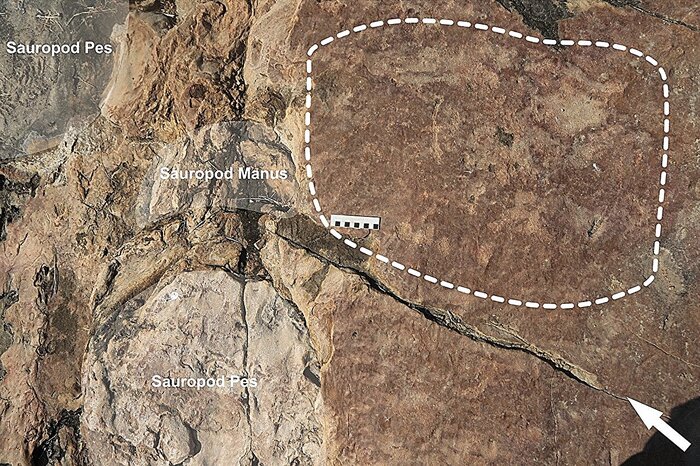In 1995, speleologists Pere Arnau and Josep Márquez discovered a small hole in the Algendar ravine, in Menorca.
After clarifying the entrance, they found a cave and within it dozens and dozens of human remains.
Archaeologists from the Autonomous University of Barcelona (UAB) took over and began an excavation that continues to bear fruit.
They counted bones of 210 people deposited there from about 3,500 years ago and for the next six centuries.
Exploring it, they found seven chambers, some with spectacular stalagmites and stalactites (see image below).
But especially the chamber that they numbered as 5 caught their attention. Located on a kind of second level, above chamber 6, it is very difficult to access even for a speleologist.
“You hardly see it.
If you want to hide something, it's the perfect place."
says Cristina Rihuete, an archaeologist from the UAB Department of Prehistory.
And there, buried under a layer of clay, they found a dozen decorated containers and, inside them, locks of hair.
Now, the chemical analysis of one of them has revealed that the bearer of that hair used hallucinogenic and psychoactive drugs.
“They used the cave as a tomb.
When a member of the group died, they left their body at the entrance and until the next burial”, says Rihuete, who did her doctoral thesis on Es Càrritx, as it is known, a quarter of a century ago and is now co-author of the study of the tufts, published today in the journal
Scientific Reports
.
At some indeterminate moment, chamber 1, the one at the entrance, also became the starting point for an intriguing ritual.
In a
post-mortem
treatment , some of those buried there had their hair dyed red (they are not sure if it is mineral ocher or vegetable red from, for example, Balearic boxwood).
Once dyed, they cut the locks, folded them and put them in wooden containers or in the horns of some herbivore.
When they discovered the locks, the technologies that today allow forensics to obtain a lot of information from a single hair did not exist.
Unlike those taken from Beethoven, which have made it possible to study their ills in depth, those hidden in Es Càrritx had been cut, which makes it difficult to recover DNA, which is concentrated in the root.
Still, they tell quite a story.
This is where Elisa Guerra, an archaeologist at the University of Valladolid, first author of the study and an expert on drug use in ancient times, comes into play.
With the collaboration of experts from the UAB and the archaeological chemist from the University of Chile, Hermann Niemeyer, they were able to analyze the hair for drugs.
They found remains of three psychoactive substances: atropine, scopolamine (commonly known as burundanga) and ephedrine.
The first two are Tropane alkaloids that occur naturally in a number of plants.
Atropine (and hyoscyamine, which is chemically almost identical) are found in belladonna and in local Menorcan flora such as Jimson Weed and henbane.
The autumn mandrake also flourishes on the island, from which scopolamine could come.
This group of alkaloids affect the central nervous system and are called delirious drugs, causing hallucinations, confusion, alterations in perception or disorganized behavior.
For its part, ephedrine, used today in many flu medications, is obtained from another Mediterranean shrub,
Ephedra fragilis
.
“There was indirect evidence of the use of psychoactive substances.
But this is the first direct evidence found in humans in Europe."
Elisa Guerra, archaeologist at the University of Valladolid
“There was indirect evidence, remains in pots, plants in the deposits, of the use of psychoactive substances even long before.
But this is the first direct evidence found in humans in Europe”, highlights Guerra.
“The concentrations that we detected throughout the hair imply that it was a prolonged and continuous consumption”, he adds.
By whom?
This point is not easy to clarify 3,000 years later, but the authors of the research have a well-founded hypothesis.
Cutting and hiding only ten tufted vessels when there were 210 people in the necropolis indicates that they were special for some reason.
"Because of the size of the houses, trousseau and other data, it has not been determined that at that time on the island there was a social stratification by wealth or class,"
comments the scientist from the University of Valladolid.
“There is another reason.
In a nearby cave, figurines with a half human, half animal shape have been found that point to the existence of religious specialists”, he adds and concludes with another argument: “These substances are dangerous, knowledge is needed to prepare and use them”.
All this leads the authors of the study to maintain that the hair belonged to a shaman.
Jordi Tresserras, an archaeologist at the University of Barcelona, agrees with the idea of the shaman.
“They were people who were dedicated to medicine, they cured physical and soul ailments,” says Tresserras, who is not related to this investigation, although he dedicated a good part of his career to studying the use of drugs in the past.
"There are examples of playful use, in Egypt, for example, but generally its use was ritualized and contextualized, being restricted to special people, such as shamans," he adds.
The Es Càrritx cave has 7 chambers.
In the first and outermost, remains of 210 people were found.
In the fifth, difficult to access, the locks of hair stored in olive wood containers.ASOME-Universitat Autònoma de Barcelona
For her part, the archaeologist from the University of Munich Vanessa Linares highlights the chemical analysis of hair as the great contribution of this work: "We can obtain information on the use of drugs in antiquity thanks to the historical, written record, such as the tablets of Sumerian clay from Nippur from 5,000 years ago (which is one of the oldest, if not the oldest, records of opium cultivation), through ancient botanical remains, dental caries, chemical analysis of artifacts, or by study of residues in ceramic vessels.
But, she adds: “What is really interesting and new about this study is that it takes chemical analysis a step further, in that they were able to take modern forensic drug testing techniques and apply them to ancient human hair.
"It's pretty hard to find evidence of the use of psychoactive plants in the West to the same extent as in the New World, where the Aztecs got high on peyote, mushrooms, and morning glory."
Nicholas R. Longrich, evolutionary biologist at the University of Bath
The discovery of the Es Càrritx cave, its hair and its drugs, is exceptional, but for the evolutionary biologist from the University of Bath, Nicholas R. Longrich, it should not have been so at the time.
“In general, it's pretty hard to find evidence of a culture of psychoactive plant use in the West to the same extent as, say, the New World, where the Aztecs got high on peyote, mushrooms, and morning glory.
But it is possible that these rituals were once more widespread and then disappeared with the spread of Christianity, ”he says in an email.
For Longrich, who has researched and written about psychoactive substances and human evolution, “there is a lot of speculation about some of the rituals and cults in antiquity;
If these religious cults, rituals and oracles used drugs, we're not really sure what they used."
This is what Longrich highlights of the Menorca work: “Could Datura [genus of plants that contain the alkaloids found in hair] have been one of the substances used in antiquity?
It's hard to say, but this raises some interesting questions.
The study is successful because it raises the possibility that we may begin to answer some of these questions by screening for these compounds."
One last question remains to be answered: why did they hide the shaman's hair after painting and cutting it?
Rihuete maintains that, coinciding with the abandonment of the cave as a necropolis, Menorca and the rest of the Balearic Islands experienced a transition (which also happened in the rest of Europe), although with its local peculiarities.
“It was the end of an era, the Bronze Age,” he says.
The existing culture is replaced by another responsible for raising the towers known as talayots and opening the way to a new time, he says.
“The Talayotic world is organized in a different way, closer to the territory than to the community with the ancestors.
In this new world where the dead cease to have relevance, someone or some hid the locks of hair ”, he concludes.
You can follow
MATERIA
on
,
and
, or sign up here to receive
our weekly newsletter
.









